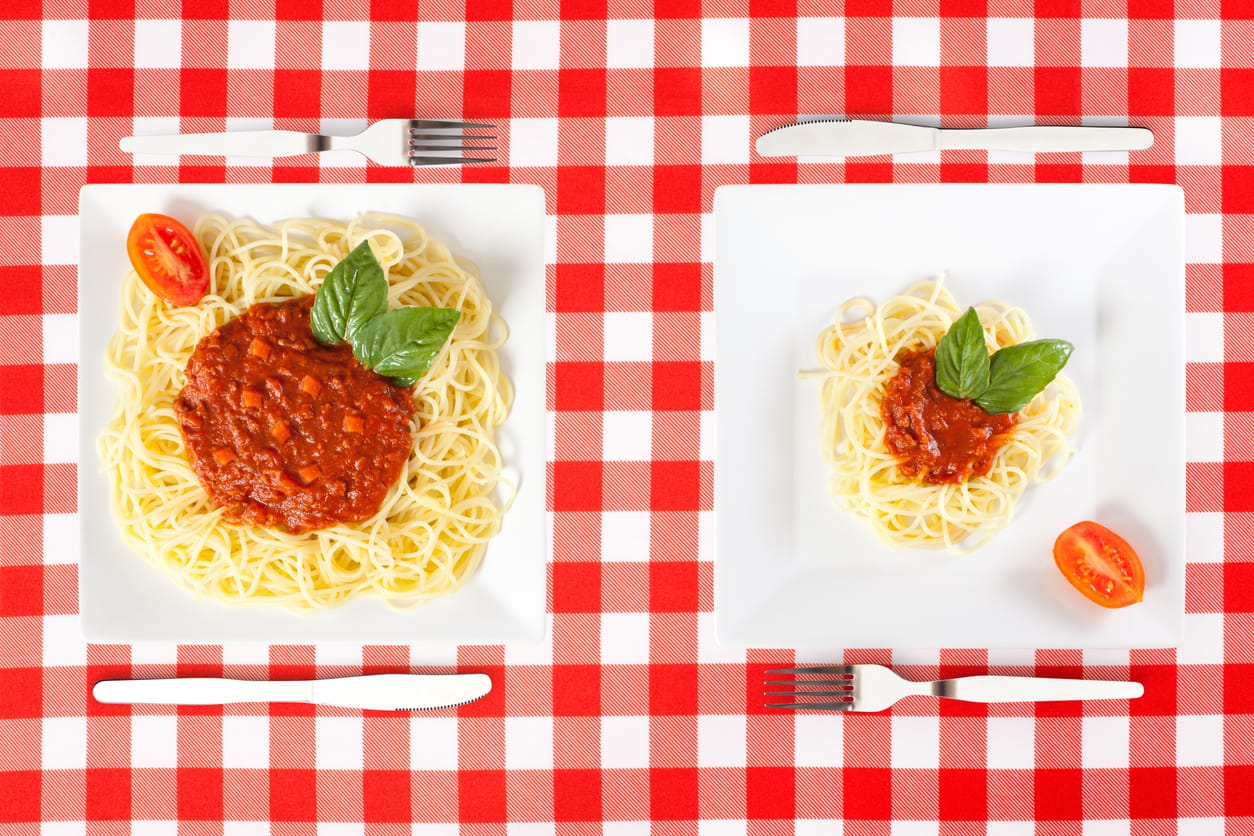Do you ever order a restaurant entrée and find that the plate set before you is huge? Portions have become bigger over the years. The problem with this is that, if we’re not paying attention, we can consume more food, more than would normally satisfy us. Or we enjoy the food so much that we hate to stop eating…and since there’s more remaining, we figure, why not indulge? In this day and age, we need to take back control over how much we consume. Here are 6 easy ways to exercise portion control, making those temptations ever so slightly easier to withstand!
1. Eat more slowly and mindfully.
Take at least 20, preferably 30, minutes to physically eat your meals, and engage mindfully with the food.

If you eat your food leisurely rather than wolfing it down, you’ll feel full after eating less. It takes 20 minutes for your brain to catch up to your stomach and tell you you’re satiated. So if you finish your meal in less than that time, you may eat a larger quantity simply because you see it on your plate, and not because you actually need it.
Eating slowly while focusing on the flavors can also allow an immensely pleasurable experience for your tastebuds. Concentrate on the flavors: is the food tangy, maybe mildly spicy, perhaps slightly sweet? Can you taste individual ingredients? Focus on any notes you can identify as well as how they meld together in the perfect way. This way you can fully appreciate your meal, whether it’s a lighter entree or rich and hearty, and be satisfied with less.
Another tip: to help with concentration, don’t watch TV or check your phone while you eat. Simply focus on the food. You may feel bored at first if you’re used to doing these things while eating, but soon you’ll find yourself getting more caught up in the physical experience of enjoying the food.
2. Pre-plan to divide restaurant meals into multiple portions.
Order the dinner portion when you go out and divide it into multiple servings, with one to be eaten later.

It might seem counterproductive to order the larger dinner portion at a restaurant. You might say, “It’s so tasty…I thought we were trying to limit our portion sizes? Won’t we just eat more, which is exactly what we’re trying not to do?”
If you order the larger entrée size, you have options, however. When you put in the order, plan to set aside ½ of the dish immediately upon receipt. (You can likely even ask the waiter to box it up in advance.) This half won’t be touched during your meal. You then only have half the original entrée in front of you to eat now. (If you think that half of an entrée may not be enough, you can always order a side, which will likely be lighter than the entrée.) You might even feel full before finishing your plate, in which case, just add these leftovers to the other portion!
You can then eat the second half for a later meal (or two more, depending on how much you set aside). Using this portioning technique, you can enjoy a satisfying, delectable meal over a longer period of time, ingesting fewer calories each time (and saving some money too!).
3. Plate size matters.
When exercise portion control at home, grab a smaller salad plate rather than a large dinner plate.

This will allow you to eat less in one go and give you time to evaluate if you want more. Feel free to fill your plate for your first serving. (You can always go back for a second serving or even a half-serving.) Then eat your food mindfully, using the techniques described in Tip #1 above. Upon finishing, wait 5-10 minutes before getting a second helping. You might realize that you don’t need as much as your eyes think you do.
4. When serving yourself meat, use your fist as a guide.
3 ounces is typically the recommended serving of meat per meal. Add more veggies rather than more meat to your plate, as part of a healthy diet.

3 ounces is roughly the size of your fist or palm. But most of us tend to cut a much larger piece of meat since that’s what we’re used to seeing. Try serving yourself a piece that’s equivalent to the size of your palm. (If this seems too drastic of a change from your normal, try reducing it by a few forkfuls, and then work your way down over time.) Then substitute more vegetables and grains in that extra space on your plate. This way you’re eating the same amount of food, but it’s just balanced differently.
Cutting your meat into more pieces can also fool your mind into thinking you’re eating more than 3 ounces when you’re really not. (Trust me, this last one has worked for me to decrease my meat intake! Somehow when I eat more mouthfuls, I feel like I’ve eaten more.)
5. Pay attention to marked serving sizes.
Look at serving sizes marked on food packages and adhere to these guidelines.

Have you ever actually looked at the serving sizes on nutrition labels for your go-to foods? Many times we just grab a handful of goodies from the box, or pour enough cereal to fill the bowl.
Next time you snag some crackers from the box in your cupboard, check to see how many crackers is one serving. Same with the cereal: measure out what the noted ¾ cup or 1 cup serving looks like compared to the bowl. Use this suggested serving amount as your guide: start out with this amount, and put the box back in the pantry. (You can always grab another serving after you’re done, don’t worry.) Feel free to add fruit to your cereal to add a bit more volume if you like. Eat your snack or meal slowly and mindfully. Once you’re done, go do something else for 20-30 minutes. Then, gauge if you still need more. If so, take another serving of the same size. If you pay attention to serving sizes, you won’t be haphazardly grabbing more than you actually need or desire, and you can more easily control your snack portions.
6. Portion out desserts into mini Tupperware containers.
Use mini containers to pre-plan your desserts for the week.

Purchase a set number of mini Tupperwares (I use five 1.26-cup Rubbermaid Takealongs). Portion out desserts among the containers, putting dessert for one day in each container. (So in my case, I assume 5 containers = 5 days.) If you bake or purchase a dessert, immediately divide it up among these containers and place them in your cupboard or fridge (not on your counter). (Out of sight, out of mind!) Since each container holds an allotted amount of dessert per day, you know in advance each day exactly how much you have available to enjoy.
It also makes it much easier to impose a limit on how much you indulge. You’re much less likely to dig into the next day’s allotment versus when you just have one large tray or box to snack from with no limit. Your desired dessert can therefore last longer, and you have more servings to enjoy.
Takeaway
We are constantly bombarded with images of heaping plates of food. Too often the servings we think of are much larger than what is healthy. Mindful eating can really help to decrease our overall consumption. Knowing appropriate serving sizes and portioning our meals, snacks, or desserts in advance can substantially help us exercise portion control and achieve a better diet.
I hope you found this article useful! For related reading, check these out:
Cover image photo credit: IStockPhoto.com/tifonimages





Great job!!! All such good advice and tips!!! 🙂
Glad you liked it! 🙂
I don’t have any issues with portion control but I know people that do.
I will definitely share these tips with the people I know that struggle with portion control because they seem easy enough for them to do.
Oh, good, glad you think this could be helpful to others in your life! Yes, of course, please share!
Great advice. I adready do 1,2 and 5. #6 and desserts are out of the question at this point.
That’s great, Sandra!
These are all great tips! I know being mindful while I am eating really helps me know when I am full!